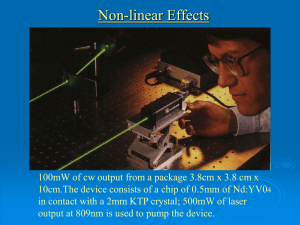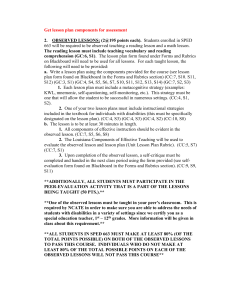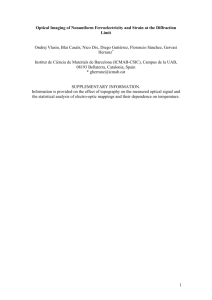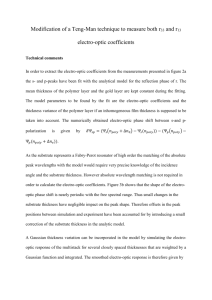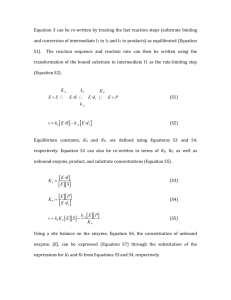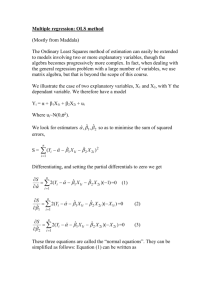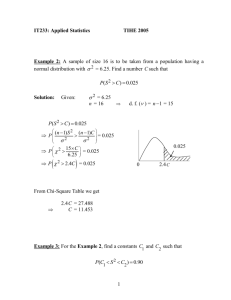Chapter 7: Electro
advertisement
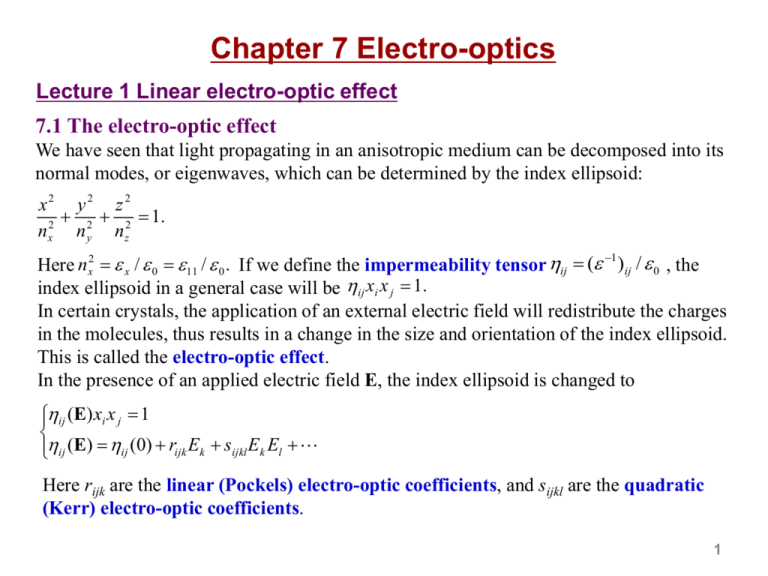
Chapter 7 Electro-optics Lecture 1 Linear electro-optic effect 7.1 The electro-optic effect We have seen that light propagating in an anisotropic medium can be decomposed into its normal modes, or eigenwaves, which can be determined by the index ellipsoid: x2 y2 z 2 1. nx2 n y2 nz2 1 Here nx2 x / 0 11 / 0 . If we define the impermeability tensor ij ( )ij / 0 , the index ellipsoid in a general case will be ij xi x j 1. In certain crystals, the application of an external electric field will redistribute the charges in the molecules, thus results in a change in the size and orientation of the index ellipsoid. This is called the electro-optic effect. In the presence of an applied electric field E, the index ellipsoid is changed to ij (E) xi x j 1 ij (E) ij (0) rijk Ek sijkl Ek El Here rijk are the linear (Pockels) electro-optic coefficients, and sijkl are the quadratic (Kerr) electro-optic coefficients. 1 From thermodynamic considerations the linear electro-optic coefficients rijk and the quadratic electro-optic coefficients sijkl have the following permutation symmetries: rijk rjik sij kl s ji kl sijlk s jilk We therefore introduce the contracted indices to replace the paired interchangeable indices: 1 (11), 2 (22), 3 (33), 4 (23) (32), 5 (13) (31), 6 (12) (21). Examples : r(12) k r( 21) k r6 k , r( 22) k r2 k , s(13)( 22) s(31)( 22) s52 The permutation symmetry reduces the number of the independent elements of rijk from 27 to 18, and that of sijkl from 81 to 36. A linear electro-optic effect is also called the Pockels effect, in which the change in the refractive index n E . Pockels effect is a second order nonlinear optical phenomenon. It only occurs in crystals that do not possess the inversion symmetry. For a crystal with the inversion symmetry, we can equivalently inverse the coordinates. ij In the orriginal coordinate s rijk Ek 'ij 'ij In the inversed coordinate s r 'ijk rijk 0. E 'k ( Ek ) Inverse symmetry r 'ijk rijk , 'ij ij 2 7.2 The linear electro-optic effect In an external electric field E the index ellipsoid is deformed into ij (0) ij xi x j 1, or 1 1 2 1 1 2 1 1 2 1 1 1 x y 2 z 2 2 yz 2 2 xz 2 2 xy 1. 2 2 2 2 2 n 1 n 2 n 3 n 4 n 5 n 6 n y nz nx For the linear electro-optic effect, the change in the coefficients is given by 3 1 2 rij E j , or n i j 1 r11 r21 1 r31 2 n r 41 1, 2 , 3, 4 , 5, 6 r 51 r 61 r12 r22 r32 r42 r52 r62 r13 r23 Ex r33 E y r43 Ez r53 r63 Here rij is the linear electro-optic (or Pockels) coefficient, and r is called the electrooptic tensor. Depending on the symmetry of the crystal, many of the elements of the electro-optic tensor are 0, and some of them have the same or opposite values. Table 7.1 in the textbook lists the point groups of crystals. We have 7 crystal systems, which lead to 32 point groups. Table 7.2 lists the non-vanishing linear electro-optic coefficients of all the point groups. Table 7.3 gives the value of the linear optic-optic coefficients of some crystals. 3 From Poon and Kim, Engineering Optics with MATLAB. 4 Example 1: KDP (KH2PO4) crystal (negative uniaxial, 4 2 m point group). The E-field is in an arbitrary direction. 0 0 0 0 0 0 0 0 E 1 0 0 0 x 0 2 E y n r 0 0 r41E x 41 1, 2 , 3, 4 , 5, 6 Ez 0 r r E 0 41 y 41 0 0 r r E 63 63 z x2 y2 z2 2 r41E x yz 2 r41E y xz 2r63E z xy 1. no2 no2 ne2 The index ellipsoid is deformed and the xyz axes are no longer the principle axes. i) For the KDP crystal, if the E field is in the z direction, we have x2 y2 z 2 2r63 E z xy 1. no2 no2 ne2 The index ellipsoid is tilted in the x-y plane. 5 It seems that we can simplify the problem by choosing a new principle axis system. We rotate the old coordinate system in the x-y plane counterclockwise by 45° and construct the new x′,y′,z′ system, that is 1 x' y', y 1 x' y', z' z x 2 2 The index ellipsoid in the new coordinate system is y' y x' x 1 2 1 2 z '2 2 r63Ez x' 2 r63Ez y ' 2 1. ne no no x '2 y '2 z '2 n3 1 If we write it as 2 2 2 1, and considerin g n 2 , nx ' n y ' nz ' 2 n 1 3 n n no r63E z o x' 2 1 then n y ' no no3r63E z 2 nz ' ne 6 ii) For the KDP crystal, if the applied field is in the x direction, then x2 y2 z 2 2 2 2r41E x yz 1. 2 no no ne The index ellipsoid is tilted in the y-z plane. We rotate the old coordinate system in the y-z plane counterclockwise by angle , and construct the new x′,y′,z′ system. Suppose the index ellipsoid in the new coordinate system is z z' n z' 2no2 ne2 r41E x tan 2 n 2 n 2 o e n x ' no 2 2 2 2 1 1 1 x' y' z' 1 1 1 2 1, then 2 2 2 2 2 r41E x 2 n x2' n 2y ' nz2' n y ' 2 no ne no ne 2 1 1 1 1 1 1 2 2 2 2 r41E x nz2' 2 no2 ne2 no ne no5ne2 r412 E x2 n y ' no 2( n 2 n 2 ) , o e For small E x , this leads to 5 2 2 2 n ' n ne no r41E x . e z 2( no2 ne2 ) y ny' y' If ax 2 by 2 cxy Ax'2 By '2 , then tan 2 c ab ( a b) ( a b) 2 c 2 A, B 2 7 Example 2: LiNbO3 crystal (negative uniaxial, 3m point group). Suppose the E-field is in the z direction. 0 0 1 0 2 n 0 1, 2 , 3, 4 , 5, 6 r 51 r 22 r22 r22 0 r51 0 0 r13 r13 r13 r13 0 r33 r33 0 E z 0 0 Ez 0 0 0 0 1 1 1 2 r13 E z x 2 2 r13 E z y 2 2 r33 E z z 2 1 no no ne x2 y2 z 2 If we write the new index ellipsoid as 2 2 2 1, then the new coefficien ts are nx n y nz 1 1 3 1 r E n n no r13 E z 13 z x, y o 2 n2 n 2 x, y o 1 1 r E n n 1 n3r E 33 z z e e 33 z 2 2 n n 2 e z 8 Lecture 2 Electro-optic modulation 7. 3 Electro-optic modulation In the example of the KDP crystal, if the external E-field is in the z direction, and the light is propagating in the z direction, the birefringence is ny ' nx ' no3r63Ez Suppose the thickness of the plate is d, and the voltage applied is V=Ezd. The phase retardation is 2 n y ' nx' d 2 no3r63V . Since the retardation is proportional to the applied voltage, we can consequently convert the polarization state of the incident light into a desired polarization by choosing the appropriate voltage. This is called electro-optic retardation. For practical use, we write the retardation as V , where V 3 is called the V 2no r63 half-wave voltage, that is the voltage for obtaining a phase retardation of . Example: For KDP at =0.55 mm, no=1.50737, r63=10.6×10-12 m/V, we have V=7.5 kV. 9 Electro-optic amplitude modulation A typical arrangement of an electro-optic amplitude modulator is shown in the figure. A KDP crystal is placed between two crossed polarizers. Also in the light path there is a quarter wave plate that introduces a fixed retardation of /2. The input light is polarized in the x-direction. A voltage of V Vm sin mt is applied in the z direction of the crystal. This is called longitudinal electro-optic modulation since the applied electric field is parallel to the direction of light propagation. The total phase retardation is 2 Vm sin mt m sin mt. V 2 The transmission of the modulator is I out 1 sin 2 sin 2 m sin mt 1 sin m sin mt . I in 2 4 2 2 For m 1, I out 1 1 m sin mt . I in 2 Therefore a small sinusoidal voltage will cause a sinusoidal modulation of the transmitted light intensity. 10 11 12 Transverse electro-optic modulation: We now consider the case where the applied electric field is perpendicular to the direction of light propagation, which is called the transverse electro-optic modulation. As shown in the figure, in a KDP crystal, the input light is polarized in the x′-z plane at 45° to each of the axes. The retardation at the output plane is then no3r63 V 2 1 3 2 ne no l transverse (nz nx ' )l l ne no no r63 E z l 2 d Here d is the thickness along which the electric field is applied. 2 For comparisio n, longitudinal 2no3r63V Compare to longitudinal electro-optic modulation, the advantages of transverse electrooptic modulation are 1) The retardation can be increased by using a longer crystal, or multiple crystals. 2) The filed electrodes do not interfere with the incident light beam. 13 Yariv, Quantum Electronics, 3rd edition. 14 Phase modulation of light In the case of KDP, if the external field is in the z direction, and the polarization of the input light is only in the x' direction, then the applied electric field will change the phase of the light, instead of its polarization. Suppose the field of the input light is Ein A cos t , the applied electric field is Em sin mt , then the field of the output light is 2 1 3 Eout A cos t no no r63 Em sin mt d 2 (omit the constant phase) 3 no r63 Em d , phase modulation index A[ J 0 ( ) cos t J1 ( ) cos( m )t J1 ( ) cos( m )t A cost sin mt J 2 ( ) cos( 2m )t J 2 ( ) cos( 2m )t ] We see that lights at side bands are generated 15 16 Reading: Lecture 3 Quadratic electro-optic effect 7. 5 Quadratic electro-optic effect The quadratic electro-optic effect is a third order nonlinear effect, where the change in the refractive index is proportional to the square of the applied fields. Unlike the linear electrooptic effect, quadratic electro-optic effect occurs in crystals with any symmetry. Using contracted indices, the index ellipsoid in the presence of quadratic electro-optic effect is Table 7.4 lists the non-vanishing quadratic electro-optic coefficients of all the point groups. Table 7.5 gives the values of the quadratic optic-optic coefficients of some crystals. 17 Example 1: Kerr effect in an isotropic medium. Let the z axis be along the applied electric field. s11 s12 1 s12 2 n 1, 2 , 3, 4 , 5, 6 s12 s12 s11 s12 s12 s11 0 0 E 2 ( s11 s12 ) / 2 0 ( s11 s12 ) / 2 0 ( s11 s12 ) / 2 0 1 1 1 2 2 2 2 2 2 2 s12 E x 2 s12 E y 2 s11E z 1. n n n 1 3 2 n n n s E 2 2 2 o 12 x y z 2 If we write it as 1 , then no2 ne2 n n 1 n 3 s E 2 e 11 2 1 The birefringe nce is ne no n 3 s12 s11 E 2 n 3 s44 E 2 KE 2 2 Here K is called the Kerr constant of the substance. 18 Example 2: Kerr effect in BaTiO3 (m3m). The applied electric field is ( E , E ,0) / 2 . s11 s12 1 s12 2 n 1, 2 , 3, 4 , 5, 6 s12 s12 s11 s12 s12 s11 1 1 1 1 2 2 2 2 s11E s12 E x 2 2 2 n n 2 E / 2 2 E / 2 0 s44 0 s44 0 s44 E 2 1 1 1 s11E 2 s12 E 2 y 2 2 s12 E 2 z 2 2s44 E 2 xy 1. 2 2 n Rotating by 45 in the xy plane gives 1 1 1 2 2 2 2 s11 s12 E s44 E 2 nx ' n 1 1 1 2 2 2 2 s11 s12 E s44 E 2 ny' n 1 1 2 2 s12 E 2 nz ' n x '2 y '2 z '2 2 2 1, and 2 nx ' n y ' nz ' 19 1 , we have 2 n 1 3 1 2 2 n n n s s E s E 44 x' 2 11 12 2 1 3 1 2 2 n n n s s E s E y' 44 2 11 12 2 1 3 2 nz ' n n s12 E 2 For s44 E 2 20
